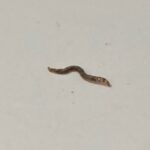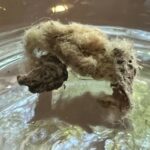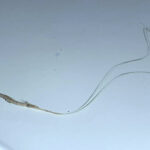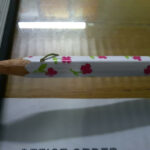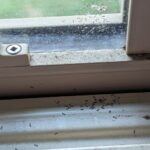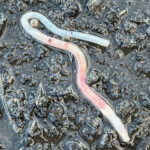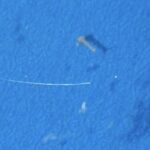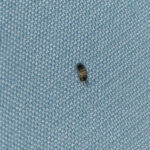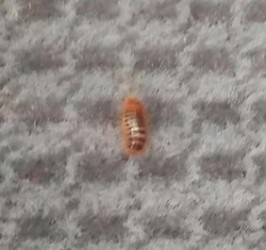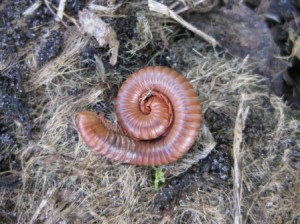
We received an interesting question from a reader recently about a brown worm or larvae that is half encased, by which we mean one end of the creature’s body is covered in some sort shell, cocoon, or other encasing, and the other end isn’t covered at all. (The picture below shows what we mean.) The worm or larvae appears to be in a middle state, as half of its body moves and wriggles around when touched, and the other half is wrapped up, seemingly prepared for a period of dormancy. The reader first found the worms next to a plant inside, but he also saw them when he was cleaning out his gutter, so evidently they are fairly common, at least in whatever part of the world our reader lives. What might these fat, brown, and partially encased worms or larvae be?
The reader sent in two pictures, but this is the clearer of the two:
The creature is in a plastic bag, which is why there is some glare in the image. As you can see, the right side of the creature looks like a plump, segmented larvae, but then the other side is, as we said above, partially encased.
When asking his question, the reader referred to what he found as a “worm,” but near the end of his question he speculated that he found “larvae of some kind.” The reader’s second instinct was right, as he did in fact find a larvae. More precisely, we think he found a caterpillar, the larvae form of butterflies and moths. Evidently, the reader found the caterpillar before it fully made a cocoon and started to transform into a butterfly – this process requires the caterpillar to essentially dissolve and reassemble into its adult form, and so the caterpillar couldn’t be wriggling around too far into this process.
Even though the caterpillar above looks like it has only completed half of its cocoon, the final encasement of some caterpillars looks like what is pictured above, where one half looks like the bottom part of a larvae, and the upper half looks more like a smooth shell. (For the record, this final encasement can be either a cocoon or chrysalis, even though most people just use the word “cocoon.” Basically, cocoons are made of silk and are built by moth caterpillars, and it is butterflies that hatch from chrysalises.) This is what Dargida procinctus, which are also called “Olive Green cutworms” or “Girdler Moth caterpillars,” look like when they are transforming into their adult form, and this is potentially the species of caterpillar our reader found.
However, there are tens of thousands of different species of caterpillars, so we don’t want to speculate on the exact species our reader found. What we can say is that he appears to have found a caterpillar that is in the early stages of transforming into a butterfly, and hopefully that is all the detail our reader needs.
All About Worms is always free, always reader-supported. Your tips via CashApp, Venmo, or Paypal are appreciated! Receipts will come from ISIPP Publishing.
You might also find these guys interesting!




